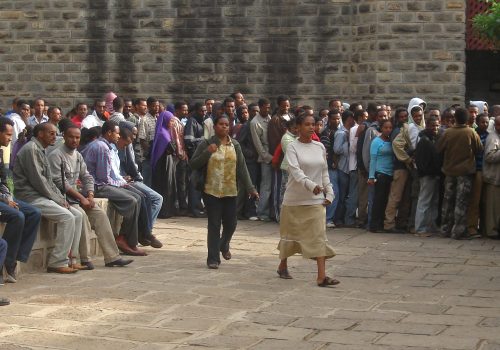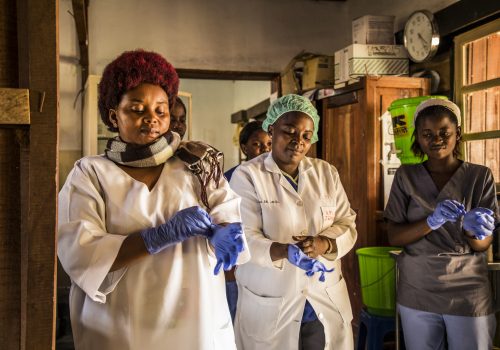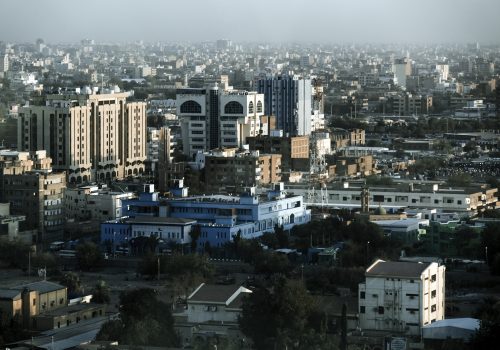Using Google reports to estimate Africa’s response to COVID-19: A compilation of the data
Despite COVID-19’s slow start in Africa and the hope that the continent might remain relatively unscathed, as of April 6, there were 9,867 confirmed cases in 51 out of the 54 countries across the continent. Similar to approaches to the pandemic globally, African government responses have varied, with common themes including border closures, banning public gatherings, and in some cases local and even nationwide lockdowns. But some responses have been more robust than others.
On April 2, Google released statistical breakdowns by country of residents’ mobility to a variety of common locations including retail and recreation spaces, grocery stores, transit stations, places of work, and residences. Each of these metrics (described below) details the percent change of mobility to each location from February 16 to March 29 against an earlier baseline. This data, which spans twenty-seven African countries, is taken from Google users that have their location trackers turned on in their phone. While it may not be representative of a broad range of socio-economic classes (and may have some statistical inaccuracies), it does provide some insight into how well government responses have fared since their implementation.
A compilation of the complete dataset for African countries is at the bottom of this page, while graphs of each of the country’s mobility over time can be viewed via individual Google country reports. Measurements do not track the entire nation, distinguish between urban and rural, and are skewed to the third of African mobile users (250 million) that can afford to buy a smartphone. Nonetheless, the data provides an imperfect framework for understanding the effect of different government responses across the continent.
The twenty-seven countries in the following dataset include Angola, Benin, Botswana, Burkina Faso, Cameroon, Cabo Verde, Côte d’Ivoire, Egypt, Gabon, Ghana, Guinea-Bissau, Kenya, Libya, Mali, Mauritius, Mozambique, Namibia, Niger, Nigeria, Rwanda, Senegal, South Africa, Tanzania, Togo, Uganda, Zambia, and Zimbabwe. Below is a breakdown of the countries with the highest and lowest percent changes in resident mobility to common locations.
Travel to transit stations:
This metric tracks mobility trends in the visits to public transportation stations including buses and train stations. This metric is vital, especially in Africa, where passengers are routinely crammed into buses, with riders overflowing the seats and aisles—putting them at a higher risk of transmission. The continued use of public transportation could have dire consequences on the number of confirmed cases across the continent. However, some African countries, through imposed travel bans, lockdowns, and restrictions on travel, have severely decreased the use of public transportation. They are listed below:
Beyond these top five countries, ten of the twenty-seven in the dataset have reported at least a 50 percent reduction in the number of people (that were tracked by Google) that have visited public transportation stations. While these numbers are quite promising, they may reflect socio-economic differences. It may be that those who own a smartphone can afford alternative forms of transportation. However, this data is consistent with the intensity of government responses in these respective countries, which have all imposed substantial restrictions to movement by March 29. In Rwanda, for example, only essential movement throughout the country is allowed. Those found driving on the streets are stopped by police and have their cars confiscated—only to have them returned after the lockdown is lifted.
The countries with the lowest percent change recorded less than a 20 percent reduction in visits to transportation stations. In a previous Atlantic Council analysis, I discuss the implications of continued public transportation use in Tanzania, which can be applied more broadly.
Travel to retail and recreation:
This metric tracks mobility trends in the visitations of places like restaurants, cafes, shopping centers, museums, libraries, and movie theaters. As listed below, eight out of the twenty-seven African countries detail at least a 50 percent reduction in their mobility to retail and recreation spaces—demonstrating the impact of government policies that shut down non-essential businesses.
In contrast, five countries tracked by Google experienced less than a 20 percent reduction in travel to retail and recreation spaces. They include:
As the data shows, the countries that have the lowest percent change in the daily travel to retail and recreation spaces are also among the countries that have some of the lowest confirmed cases on the continent. For example, Zimbabwe with only nine confirmed cases has only a 2 percent change since February 16—by far the lowest among countries within the Africa dataset. This suggests that those monitored by Google living in Zimbabwe are not avoiding trips to crowded retail and recreation spaces as a preventative measure against COVID-19. This may be evidence that individuals in countries with fewer cases may feel less motivated to change their daily behavior.
Travel to grocery and pharmacy:
This metric tracks mobility trends in the visitations of places like grocery stores, specialty food shops, drug stores, and pharmacies. It is not clear whether or not this metric includes visits to local village markets. The countries with the highest percent changes are listed below:
Six of the twenty-seven countries (tracked by Google) recorded at least a 40 percent reduction in the amount of people visiting grocery stores and pharmacies since February 16.
In contrast, Ghana is the only country in the dataset to endure an increase in the number of people going to grocery stores and pharmacies. However, just days before Google’s data collection concluded, Ghana imposed a lockdown. This latest percentage increase likely reflects people across the country preparing to stay at home and abide by the lockdown order. Previous to the announcement, Ghana had recorded substantial decreases in the number of people going to grocery stores and pharmacies—upward of a 20 percent reduction.
Four other countries: Botswana, Tanzania, Zambia, and Mozambique have also endured lower percent changes in the number of people going to the grocery store and the pharmacy compared to the rest of the countries in the dataset.
Travel to places of work:
This metric tracks mobility trends of places of work. This metric may be problematic since work in most African nations occurs in the informal economy which does not necessarily have a physical address. Regardless, this data provides an idea of the extent to which the government lockdowns and policies have impacted normal work activities; or in the case of the bottom ranking countries, how life is business as usual.
Again, the top countries with the highest percentage change in travel to places of work are among countries that took immediate preventive actions against COVID-19. Although the individual countries have endured a wide range of reductions, spanning from 30 to almost 70 percent.
The countries with the lowest percent reductions demonstrate a lack of change to the daily work routines of the individuals that were tracked by Google. Three countries including Ghana, Benin, and Mozambique recorded an increase in the number of people that traveled to a place of work. Meanwhile, the remaining countries on the list either reported no change or a relatively small reduction of 3 percent.
Staying at home:
One of the best metrics provided by Google is the mobility trends for places of residence, representing tracked users staying at home during the outbreak.
Coinciding with the other findings, as residents of Mauritius, South Africa, Rwanda, Angola, and Cabo Verde reduce their travel to usual destinations, they are increasingly staying at home. Although every African country in the dataset has experienced an increase in the number of their residents that are staying at home, six countries including Tanzania, Benin, Cameroon, Ghana, Mali, and Niger have endured less than a 10 percent increase. Tanzania has had the lowest percentage change, with only a 3 percent increase of its tracked residents staying at home, compared to the baseline figures from earlier this year. This may reflect the rhetoric of President Magafuli, who recently encouraged Tanzanians to continue to attend places of worship.
Conclusion:
The major finding across the Google metrics is the consistency of countries appearing in the top and bottom lists for percent change in mobility to the various common locations. Countries with the highest percent change in metrics across the board—including travel to retail and recreation spaces, grocery stores, transit stations, workplaces, and places of residence—include Angola, Cabo Verde, Mauritius, Namibia, Rwanda, and South Africa. These numbers most likely reflect the stringent restrictions on travel imposed by the governments of the aforementioned countries. In contrast, the countries with the lowest percent change in mobility to the various common locations include Benin, Botswana, Ghana, Tanzania, and Zimbabwe—possibly reflecting unchanged daily behavior and continued travel amongst those tracked.
Thus, as the data supports, these residents were not staying home as compared to the rest of the countries in the dataset. Since people in these countries are not practicing social distancing and staying at home, it is a fair prediction that the number of cases is likely to rise steeply in the coming weeks. These Google metrics, although an imperfect framework, provide valuable data that should continue to be released periodically to help inform governments and policymakers alike of the progress made by lockdowns and travel restrictions.
Neil Edwards is an intern with the Atlantic Council’s Africa Center.
Want to read more on this data and its implications? See additional visualizations and a summary of key thematic findings here.
Questions? Tweet them to our experts @ACAfricaCenter.
For more content, go to our Coronavirus: Africa page.
Image: Transit activity at the Nyabugogo bus station in Kigali, Rwanda prior to the coronavirus pandemic. (Flickr/Francisco Anzola)


